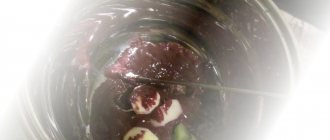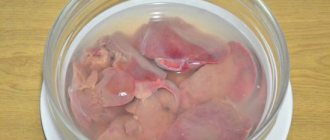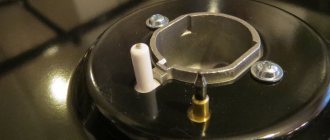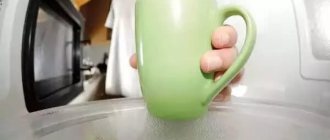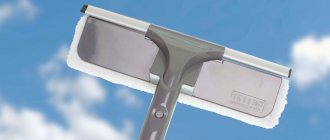Trying to save money, housewives often resort to methods they themselves invented. One of these is sterilizing a kitchen sponge in the microwave. It is believed that this procedure destroys all microorganisms that remain in the porous material, and, accordingly, extends the service life of the sponges. Let's try to figure out whether this is really so and whether any processing is needed at all.
Quick coffee made from ground beans
Coffee in the microwave is real, although not as appetizing as in a good coffee shop.
Recipe:
- Take a cup whose walls are not heated by microwaves.
- Add 2-3 tsp. ground beans and pour 250 ml of cold water.
- Add the sugar right away so you don’t have to stir up the grounds later when stirring.
- Loosen it, for example, with a sushi stick.
- Warm in the microwave for 1-3 minutes - make sure that the coffee rises, but does not run away (do not boil).
- Pour in 1 tsp. cold water and go wash or apply day cream.
- After 2 minutes the coffee settled and brewed - bon apetit!
Another secret with coffee I’m an absent-minded person, I often brew coffee back to back and don’t wait for it to settle. And I regularly forget to buy filter paper. Instead, I cut a Zeva paper handkerchief into quarters, separate 1 layer and put it in a strainer. It takes a little longer to filter, but it retains all the crumbs.
Make plasticine at home
A few simple ingredients and a microwave can help you make homemade clay.
Mix a cup of water, food coloring and a tablespoon of vegetable oil in a microwave-safe bowl. Whisk in two teaspoons cream of tartar (available in the spice department), a third cup salt and a cup flour.
Cover the bowl with a paper towel and microwave for 30 seconds. Stir the mixture again and microwave again for 30 seconds. Repeat 2 more times. If there is a lot of water left in the mixture, repeat the procedure again.
Chill and sculpt with your kids.
Does the microwave kill bacteria?
This depends on the structure of viruses and bacteria, as well as the operating mode of the device. If you put food to defrost, the bacteria that were in the food will remain in it.
Does the microwave kill bacteria?
- When defrosting food using a microwave, you should not hope that this method of processing will be able to kill viruses and bacteria. When using the normal heating mode, it will not be possible to kill viruses and bacteria.
- If baking is carried out, or heated to 100 degrees, then indeed most of the microorganisms will die.
- But here it’s not the microwave at all, but the effect of high temperature. However, some bacteria, for example, the causative agent of anthrax, survive at temperatures of 100 degrees.
How to use Kraft bags for sterilizers
Kraft bags for sterilization are used in cosmetology, medicine and beauty salons. They allow instruments to remain sterile for longer and also demonstrate to clients that all instruments have undergone the necessary processing. We understand what craft bags are, how they are used and answer common questions.
What are kraft bags, their types
A Kraft bag is a multilayer paper product made from pine needle sulphate pulp.
Depending on the manufacturer, the raw materials can be bleached or regular brown, which affects the final color of the package. The properties of raw materials and production technology give the craft bag unique qualities:
- it allows oxygen to pass through, but does not allow germs to enter;
- despite the permeability of the surface, the packed bag remains sealed;
- the paper does not get wet, therefore it is suitable for sterilization in an autoclave;
- craft paper has high heat resistance.
Kraft bags are used in all areas where instrument sterilization is required - in medicine, beauty salons, cosmetology.
The use of this product allows you to maintain the sterility of the instrument longer, and also increases the confidence of the client - opening the packaging confirms the sterilization procedure.
There are three types of packages:
- for air sterilization, that is, for dry heat;
- for steam - autoclaves;
- universal.
Be sure to pay attention to the purpose of the package when purchasing, since a product for a dry-heat oven is not suitable for use in an autoclave, and vice versa.
A Kraft bag may have one transparent side made of heat-resistant polyethylene. Such packaging is usually used in medical institutions, but can also be used in beauty salons. The transparent side allows you to see which set of tools is in the bag.
There are also several types based on the sealing method - with thermal soldering, paper clips and self-adhesive tape. The latter option is most often presented in stores, as it is easy to use and has average indicators for maintaining the sterility of manicure or medical instruments.
If the bag has a thermal seal, you need to purchase a special sealer for it - a device with heated rollers.
Kraft bags have a separate classification based on their information content:
Manufacturers place class I indicators on the surface of paper bags. These indicators indicate that the package has been exposed to temperature. First class indicators cannot be considered reliable regarding the quality of sterilization, since they change color before the sterilization cycle in a dryer or autoclave ends. The indicator will also change color under external influence, for example, if it is heated over a candle.
The fact described above does not negate the fact that class I indicators confirm sterilization, but they should not be the only indicator of its quality and correct operation of the sterilizer.
To be sure that the sterilizer is working correctly, additionally use indicators with craft bags:
- 4 classes. External indicators that are laid out in the dryer chamber and indicate its correct operation and uniform heat distribution;
- 5th grade. Internal indicators that are placed inside the package along with the tools. Class 5 indicators indicate that a high temperature was maintained inside the package for the required time. They are proof of the sterility of the instruments inside the package.
Indicators of classes 2 and 3 are not used in the beauty industry: class 2 is intended for special medical tests, and class 3 is for narrow applications and is practically not used.
Manufacturers
Vinar
Vinar is a manufacturer of consumables for beauty salons, cosmetology clinics and medical institutions.
Vinar “Sterit” craft bags have a self-sealing side. Made from waterproof craft paper. Suitable for sterilization in dry heaters and autoclaves. The front side indicates what color the indicator should acquire after treatment with steam or dry air.
The choice of sizes is huge – from small 50*170 mm to large – 600*500 mm.
The cost depends on the size, for example, 75*150 – 240 rubles per package of 100 pcs.
There are also combined options made of film and paper with a transparent side. The packaging remains sterile for up to 60 days, as it has a thermal seal. The bags are sealed using a special roller sealer.
Medtest
Like Vinar, Medtest has bags made of different materials and for different sterilization methods. The PSPV-Sterimag series is a combination of adhesive packaging with a transparent polyethylene side. Suitable for all types of sterilization. Price – from 180 rub. for 100 pieces.
There are classic brown paper ones - PBSP. Dimensions from 75*150 mm to 300*450 mm.
The catalog presents packages separately for steam and air sterilization, as well as options with heat sealing.
Price per pack of 100 pcs. from 150 rubles, depending on size.
DGM Steriguard
The bags are made of white, but not artificially bleached paper. Available in several sizes. The clasp is adhesive. Suitable for steam, air, gas and other types of sterilization.
The packaging has a 1st class indicator, as well as a place to fill out information about the contents, date and time of processing.
The sizes, like all manufacturers, are different - from 75*150 mm. and higher. Price – from 250 rub. per package. There are also regular, brown craft bags that are universal for all types of sterilization. Price – from 200 rub.
How and with what to disinfect, sterilize and clean manicure instruments
Advantages and disadvantages
Housewives who have used a microwave for sterilization not for the first time have already appreciated the advantages of this method:
- unlike sterilization “the old fashioned way”, the method takes a minimum of time;
- disinfecting sponges or kitchen rags with high temperature is more effective than hand washing or washing;
- glassware and tempered ceramics can withstand the process without problems.
There are also disadvantages:
- oven capacity is limited. For example, only one three-liter jar fits in an “average” microwave;
- Do not place dishes with metal elements in the microwave!
APPLIANCES IN YOUR KITCHEN
Every family wants to be sure that the equipment in the house does not pose a threat to health. Today there is practically no family that does not use a microwave oven. But the question of whether it’s worth buying a microwave often arises in many people’s minds.
Real scientific studies of the harmful effects of stoves on human health were carried out a long time ago and there were few of them. In many articles, the harm from microwave ovens is assessed differently.
Let's start with the fact that microwave ovens are an indispensable attribute of almost any kitchen. Almost all housewives use them for heating food, preparing simple dishes, and defrosting. Using a stove saves time and completes some tasks faster than a stove.
Is it possible to use a microwave to sterilize masks?
Reusable protective face coverings must be sterilized after 2 hours of use. Bacteria and viruses quickly accumulate on the inside and outside, and if disinfection is neglected, products become not only useless, but also dangerous.
The classic method of sterilization is washing. It is not always convenient to resort to it; it takes time, and besides, the washed product takes a long time to dry. As an alternative, some people suggest cleaning the mask in the microwave.
Ovens are indeed suitable for sterilizing fabrics against coronavirus. Although microwaves themselves do not have any disinfecting properties, the material becomes very hot during the processing process. And the coronavirus dies at temperatures above 56 °C.
The main method of disinfection of medical protective dressings is thermal, and microwave is well suited for disinfection. Important! The disadvantage of this method is that experts do not recommend disinfecting fabrics in the microwave for cooking. You need to buy a separate oven for processing protective equipment.
Antiseptic treatment
Protective dressings can only be disinfected with alcohol-based antiseptics with a concentration of 60% or more. Suitable:
- formic alcohol;
- boric alcohol;
- pepper tincture;
- "Aseptolin"
You can make your own antiseptic.
To watch the video:
How to make liquid to disinfect masks
Disinfectants that can destroy coronavirus must contain alcohol with a concentration of at least 60%. Ingredients for preparing the disinfectant solution:
- ethyl alcohol 96% - 80 ml;
- glycerin - 15 ml;
- hydrogen peroxide - 5 ml.
Mix everything and pour into a bottle or spray bottle. Wipe PPE on both sides as necessary.
Vodka-based antiseptics are ineffective, since the alcohol concentration is only 40%. Various mixtures based on aromatic oils are also ineffective.
Does the microwave kill germs?
On the Internet you can find thousands of articles about the dangers of microwave ovens - about the danger of their radiation for the human body. Since microwaves are “trying to kill us,” maybe they can deal with bacteria? They are smaller, which means the process should be easier.
It would seem logical, but no:
- To date, there is not a single scientific study that would prove the effectiveness of electromagnetic radiation in the fight against bacteria;
- The main effect on microbes is due to high temperatures;
- Not all microorganisms are sensitive to these very high temperatures;
- You can't kill all bacteria with a microwave oven.
.
Most bacteria die within 20 seconds when the temperature rises to 75 degrees. Boiling for a minute will kill almost all pathogens.
Read also: Why do people need measurements?
But there are exceptions - some microbes survive prolonged boiling without any harm.
When heating in the microwave:
- It is better to choose maximum power in order to achieve the highest possible temperatures;
- Treatment for a few minutes will help get rid of 90% of bacteria;
- Properly prepared and processed food should not contain pathogens, in principle;
- The entire gastrointestinal tract is populated by opportunistic flora; there is no need to be afraid of a small “gain”.
Why should you clean your sponge regularly?
E. coli bacteria are hidden in 44% of kitchens, and they are mainly found in sponges and dish towels. This bacteria is most often harmless, but some strains can cause diarrhea, cramps and vomiting. One study conducted in Japan found that kitchen sponges are second only to drainage filters when it comes to the highest levels of bacterial contamination in the home.
Your sponge may also harbor other types of bacteria, such as Staphylococcus aureus or Campylobacter, which will also lead to diarrhea. You're probably more than ready to clean that sponge right now, right?
The general recommendation is to simply do this daily.
Is it possible to disinfect a mask in the microwave?
It is possible, but it is better not more than once. Although this does not provide a complete guarantee of disinfection, it is advisable to discard the disposable mask after 2 hours of wearing it.
Important! Masks that do not have metal parts (often a nose clip) can be sterilized in a microwave oven.
Procedure:
- Apply an antiseptic (at least water) to the mask. This will moisturize and further disinfect.
- Place the mask with the inner side (which is adjacent to the face) facing up
- Turn on power 800 watts
- Set the operating time to 1 minute
In this way, you need to process one mask at a time; you should not put them in a pack.
Frequent disinfection leads to degradation of the mask fabric. Therefore, you should resort to this method as a last resort.
Can disposable masks be washed?
According to the current Sanitary Regulations, disposable protective equipment is not allowed to be disinfected for reuse. The surgical mask is made of non-woven material, which is easily destroyed by washing and steam treatment. They should be discarded after two hours of wear.
But in times of shortage, disposable PPE can be disinfected to be used for shopping or when caring for a sick family member. Acceptable methods of treatment are wiping with an antiseptic, ironing, and ultraviolet irradiation.
You can wash a disposable mask only once. After the second wash, the non-woven material unravels and the PPE becomes unusable.
To watch a video about processing a disposable mask:
What tricks won't save a kitchen sponge?
Below are methods that are not recommended for cleaning sponges.
- Hot soapy water. Tap water is not hot enough to get rid of germs. You can soak the sponge in boiling water for a while if you don't have a microwave or dishwasher.
- Soaking in bleach. Heat is more effective than bleach for this purpose. Heat kills pathogenic microorganisms. Also, if you're trying to bleach your washcloths, the powder doesn't always saturate the entire fabric. And you're at risk because the bleach can remain on the sponge and end up on your cooking surface and food.
When should a sponge be disposed of?
There will come a time when you should just throw away the sponge. Two weeks is the maximum life expectancy for a typical housewife's kitchen assistant.
Replacing it regularly, at least every 14 days, will prevent the spread and growth of bacteria. You should also disinfect or replace the sponge if it smells funny.
According to experts, cleaning kitchen sponges does not actually get rid of bacteria 100%. It may be better to simply replace them every week than to try to give them a second life.
Found a violation? Report content
Microwave method (for sponges that do not contain metal inclusions)
- Wet the sponge completely, and without letting it dry, put it in the microwave. Caution: Some sponges may contain plastic, which will melt in the oven even if the sponge is very wet. Place a paper towel under the sponge so that if it starts to melt, you won't stain the stove.
- Place the sponge in the microwave and microwave for at least one minute. According to a study conducted by the Department of Agriculture, exposure to microwave waves for one minute significantly reduces bacterial (as well as fungal) contamination than other methods. The researchers also found that after two minutes of exposure, more than 99% of all bacteria and fungi die.
- Place half a cup of water in the microwave along with a sponge for an even stronger moisturizing effect. After the oven stops working, carefully remove your sponge and let it cool slightly before using it. If you do not allow the sponge to cool before squeezing it, you may suffer serious burns.
Soaking method
- One study suggests that the soaking method is not as effective as previous ones, but this method still helps a lot.
- Wear rubber gloves to protect your hands when performing the following steps.
- Clean the sponge using tap water and dish soap. Rinse the sponge thoroughly under running water.
- Mix a 10% bleach solution in a small bowl. Use hot water to maximize the effectiveness of the bleach (hot water makes the bleach molecules more active, thereby increasing its effectiveness). A plastic food container is perfect for serving as a bowl.
- Place the sponge in the container for 5-10 minutes to soak it as much as possible. You can also squeeze it in a solution. This will ensure that the bleach penetrates completely into the sponge and cleans out any organic debris.
- Remove and rinse under running water.
Adviсe
- You can order a general cleaning of your apartment from our company, we bring our own sponges!
- Once you remove the sponge from the microwave, there will be a lot of steam and moisture left behind, which can loosen stains and dried-on food debris. So. After this procedure, be sure to wipe the inside of the microwave with a paper towel or a simple rag.
- After using the sponge, rinse it under water and wrap it in a paper towel so that it absorbs all excess moisture. A more environmentally friendly and generally less wasteful way is to use a kitchen towel instead of a paper towel.
- Use cloth kitchen towels for wiping floors, tables, spills, etc. This way you will save on paper towels and increase the life of your sponge.
- If you want to kill not only all spores but also bacteria using a microwave, then try to be sure. That the sponge will be wet for the entire 5 minutes, otherwise it may melt or even catch fire.
- Replace the sponge regularly. Buy sponges labeled “germ-resistant” at the store to increase protection against microorganisms.
- Try not to use your sponge everywhere. For example, to wipe meat juices off a cutting board, get a separate towel. Paper ones are great, but to save money you can also get rag ones.
- Use a little lemon or lemon cleanser when you sanitize your sponge with bleach to help combat the bleach smell. You can also immediately use scented bleach. After this procedure, be sure to rinse the sponge under running water.
PRECAUTIONS WHEN CLEANING THE KITCHEN SPONGE
- When using the microwave method, be careful when removing the sponge from the oven. The moisture can be very hot and you will get burned.
- Do not put the sponge in the microwave for more than 5 minutes, otherwise it may cause a fire.
- Before cleaning in the dishwasher, check the manufacturer's instructions or look on the website. Some dishwasher manufacturers and repairers do not recommend using this method, as pieces of the sponge may break off and become stuck in the mechanism.
- Your microwave may smell bad if a moldy sponge starts to burn in it.
- Our body needs bacteria, since there are not only bad ones, but also beneficial ones. Also, to improve our immune system, we need the body to fight harmful bacteria. So, don't keep everything sterile clean, it can be bad for your immune system.
- Never put a sponge that is dry or barely damp into the microwave oven as this may cause a fire.
Coronavirus in the microwave: will it survive or not?
Along with chemical means of fighting viruses (alcohols, chlorine-containing substances, soap), viruses can also be killed by high ambient temperatures. And one way to expose them to temperatures unacceptable for their existence is to treat objects with microwave radiation. Or microwave field. Now let’s figure it out: does the coronavirus die in this field or not? Viruses (including coronaviruses) are a form of life with the prefix “pseudo”. They cannot reproduce and live outside living cells (obligate parasitism); outside of them they simply behave like chemical substances. Therefore, finding remedies against viruses is not so easy. And sometimes it is not yet possible (for example, HIV). But outside living cells they are vulnerable, since the most severe measures can be applied against them without fear of damaging the cellular structures in which they live.
Microwaves, even at high intensity, may not damage the structure of any substance. If there are no dipole molecules in it. The simplest and most common dipole is H2O, ordinary water.
The principle of its operation is based on heating water in a microwave oven.
From your school physics course, you must remember that the more intense the molecular motion, the higher the temperature of the environment of the moving molecules. And the microwave field intensively “swings” the water dipoles. Thus increasing their temperature, and they already increase the temperature of the substance surrounding them.
Even the most complex viruses do not contain water in their protein shell . It consists entirely of nucleic acids, being a fragment of the nucleus or cytoplasm of the host cell. Exposure of viruses to microwave radiation in this state means irreparable damage to the body of the virus carrier.
Therefore, there can be no talk of microwave treatment of living organisms.
Rules for disinfection in the microwave
Regular disinfection is necessary for personal hygiene items: toothbrushes, combs. For disinfection, one minute of heating at maximum power is sufficient.
Soak a dishwashing sponge in warm water (you can add a little lemon juice - 1 teaspoon per glass). Warm up at maximum power (1-1.5 minutes is enough), then let cool and rinse with clean water.
Cutting boards, especially those on which you cut raw meat or fish, also need to be disinfected. Before the procedure, wash the boards thoroughly and rub both sides with half a fresh lemon. Run the microwave for one, maximum, one and a half minutes.
Rule one. Change dish sponges more often
There is a simple truth: items used to clean your home must be clean. Do you think there is a contradiction in this? Not at all! Mops, brooms (who still use them), vacuum cleaners and kitchen sponges laboriously and unquestioningly collect dirt for us and, unfortunately, accumulate it. Perhaps for some, a kitchen sponge is good and cute until it loses its presentation. In fact, it needs to be changed, practically, on a schedule. I took the sponge into circulation, allowed it to undergo water procedures - make a note on the calendar. If you do not use it too often, limiting yourself to snacks and cooking only on weekends, change the sponge once a month. If you have children and you cook every day, change it once every 2 weeks, or better yet, once a week. And pay attention to the place where the sponge whiles away its free time. Any humid environment is a breeding ground for bacteria!
How to properly treat a sponge?
To disinfect a kitchen sponge, it should be soaked in a 20% solution of sodium hypochlorite (popularly called bleach), and then processed in an autoclave. However, it is unlikely that foam rubber will withstand such abuse, and the cost of the procedure will be several times higher than the price of a new clean sponge. Therefore, you should not sterilize at home - it is better to simply throw away the used item.
Whether to continue sterilization in the microwave after reading this article is up to everyone to decide for themselves. However, you should never forget that the price of a piece of foam rubber and human health are incomparable.

